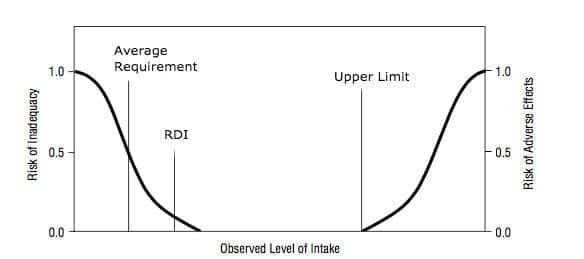

When trying to consume a healthy diet, it helps to have an understanding of how much of each nutrient you should aim to consume. Several targets have been created so that you eat the right amount of each nutrient.
The most popular and common of these in the U.S. is the Daily Value or (%DV). This is the percentage that you see on all nutrition facts labels. In addition to this, there is the Reference Dietary Intake (RDI), and Tolerable Upper Limit (UL) that any person should consume.
The reference dietary intake (RDI) gives numbers based on age and gender. The Daily Value (DV) builds on the RDI, but creates a number meant for everyone that can be put on the labels of food products.
In short, the RDI is more specific and the DV is more general.
If you are confused, don't worry, this article will clarify it for you, and give you a table with all the numbers.
This table is for an adult male, average weight of 154lbs (70kg) and height of 70inches (177cm).
| Macronutrients | |||
| Nutrient | RDI | DV | UL |
| Calories | 2000 | 2000 | N/A |
| Fat | N/A | 78g | N/A |
| Saturated Fat | N/A | 20g | N/A |
| Cholesterol | N/A | 300mg | N/A |
| Carbs | 130g | 275g | N/A |
| Fiber | 38g | 28g | N/A |
| Sugar | N/A | 50g | N/A |
| Protein | 56g | 50g | N/A |
| Vitamins | |||
| Nutrient | RDI | DV | UL |
| Vitamin A | 900mcg (RAE) | 3000IU | 3000mcg (RAE) |
| Vitamin B1 | 1.2mg | 1.2mg | N/A |
| Vitamin B2 | 1.3mg | 1.3mg | N/A |
| Vitamin B3 | 16mg | 16mg | 35mg |
| Vitamin B5 | N/A | 5mg | N/A |
| Vitamin B6 | 1.3mg | 1.7mg | 100mg |
| Vitamin B9 | 400mcg | 400mcg | 1000mcg |
| Vitamin B12 | 2.4mcg | 2.4mcg | N/A |
| Vitamin C | 90mg | 90mg | 2000mg |
| Vitamin D | N/A | 20mcg | N/A |
| Vitamin E | 15mg | 15mg | 1000mg |
| Vitamin K | N/A | 120mcg | N/A |
| Choline | N/A | 550mg | 3500mg |
| Lycopene | N/A | N/A | N/A |
| Lutein+zeazanthin | N/A | N/A | N/A |
| Minerals | |||
| Nutrient | RDI | DV | UL |
| Calcium | N/A | 1300mg | 2500mg |
| Copper | 0.9mg | 0.9mg | 10mg |
| Iodine | 150mcg | N/A | 1100mcg |
| Iron | 8mg | 18mg | 45mg |
| Magnesium | 400mg | 420mg | N/A |
| Manganese | N/A | 2.3mg | 11mg |
| Phosphorus | 700mg | 1250mg | 4000mg |
| Potassium | N/A | 4700mg | N/A |
| Selenium | 55mcg | 55mcg | 400mcg |
| Sodium | 1500mg | 2300mg | N/A |
| Zinc | 11mg | 11mg | 40mg |
| Ash | N/A | N/A | N/A |
| Water | N/A | N/A | N/A |
| Carbs and Sugars | |||
| Nutrient | RDI | DV | UL |
| Starch | N/A | N/A | N/A |
| Sucrose | N/A | N/A | N/A |
| Glucose | N/A | N/A | N/A |
| Fructose | N/A | N/A | N/A |
| Lactose | N/A | N/A | N/A |
| Maltose | N/A | N/A | N/A |
| Galactose | N/A | N/A | N/A |
| Fatty Acids | |||
| Nutrient | AI* | DV | UL |
| Omega 3s | 1.6g | N/A | N/A |
| Omega 6s | 17g | N/A | N/A |
| Amino Acids | |||
| Nutrient | RDI | DV | UL |
| Tryptophan | 280mg | N/A | N/A |
| Histidine | 700mg | N/A | N/A |
| Threonine | 1050mg | N/A | N/A |
| Isoleucine | 1400mg | N/A | N/A |
| Lysine | 2100mg | N/A | N/A |
| Leucine | 2730mg | N/A | N/A |
| Methionine | 728mg | N/A | N/A |
| Cystine | 287mg | N/A | N/A |
| Phenylalanine | 875mg | N/A | N/A |
| Tyrosine | 875mg | N/A | N/A |
| Valine | 1820mg | N/A | N/A |
| Arginine | N/A | N/A | N/A |
| Alanine | N/A | N/A | N/A |
| Aspartic Acid | N/A | N/A | N/A |
| Glutamic Acid | N/A | N/A | N/A |
| Glycine | N/A | N/A | N/A |
| Proline | N/A | N/A | N/A |
| Serine | N/A | N/A | N/A |
| Hydroxyproline | N/A | N/A | N/A |
*Adequate Intake is assumed to ensure nutritional adequacy and is established when evidence is insufficient to develop an RDI.

In the "Bathtub" curve graph below, we see that the RDI is set to cover 98% of all people, and is considerably higher than the "average amount" most people need. After that, there is generally a wide gap where you can consume more of a nutrient, before hitting the Upper Limit where problems from toxicity may occur.
Determining a Dietary Reference Intake depends on a variety of factors and varies from person to person. Age, gender, height, and weight, are 4 of the main factors used. Here are the characteristics for males and females used in determining the RDIs:
For Males aged 19 to 30
BMI - 22.5
Height 177cm (70 inches)
Weight 70kg (154lbs)
For Females 19-30
Average BMI - 22.5
Height 177cm (70 inches)
Weight 70kg (154lbs)
In short, the Dietary Reference Intake (RDI) tries to define how much of a nutrient each person should have based on their age and gender. The Daily Value (DV) builds on the RDI but is an overall figure that should work for everyone, regardless of age, gender, etc. Therefore, the DV tends to be higher than the RDI. The Upper Limit (UL) is simply the highest amount of any nutrient you should consume. So while the RDI sets the target, the UL sets the limit.
MyFoodData provides free nutrition data tools and articles to help you organize and understand the foods you eat.
Create a free account to log and track foods.